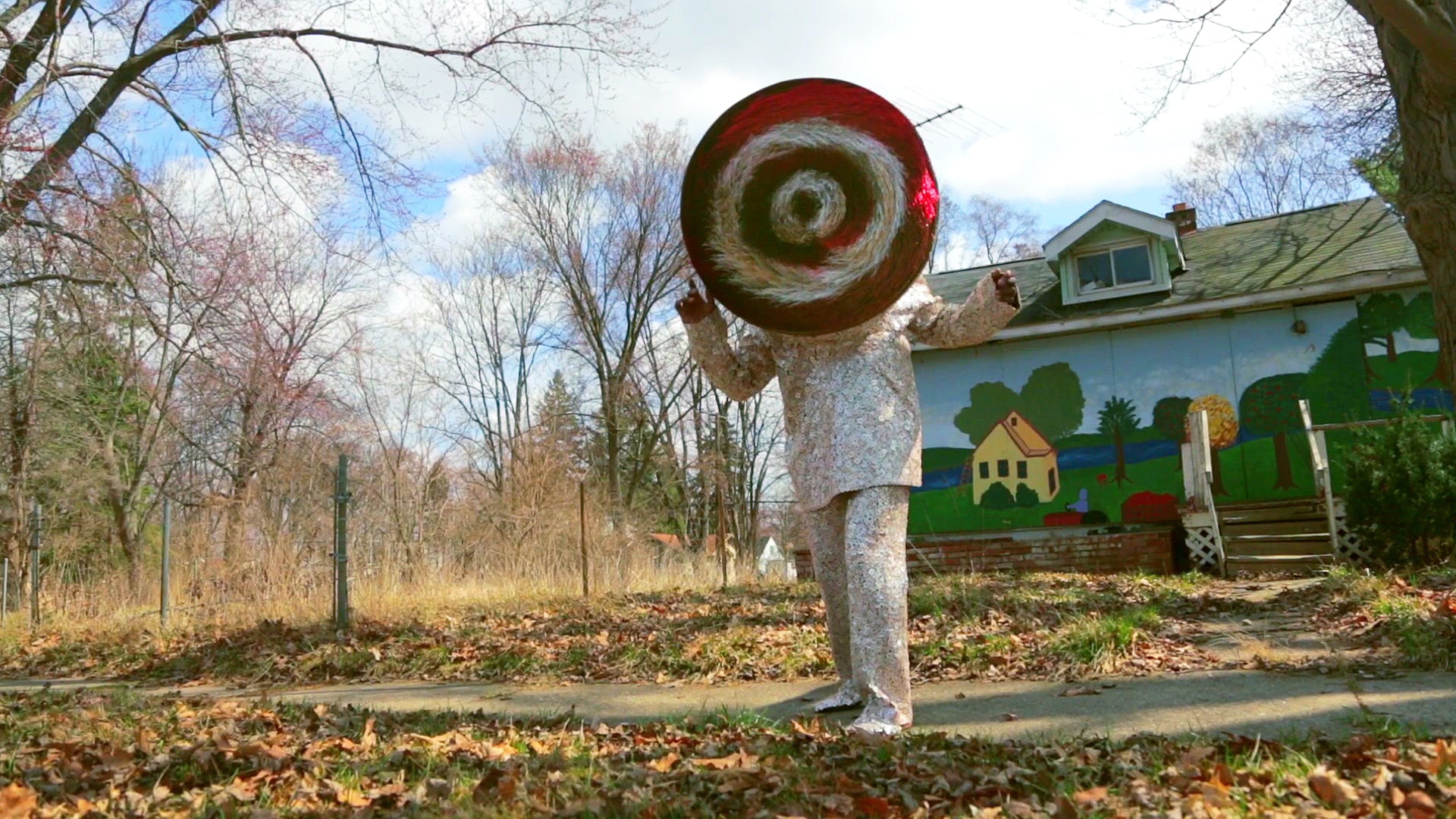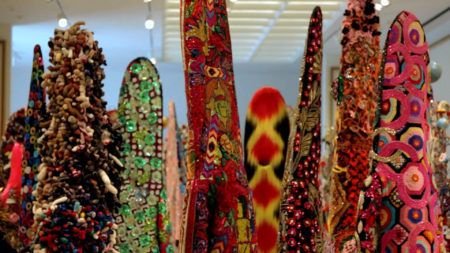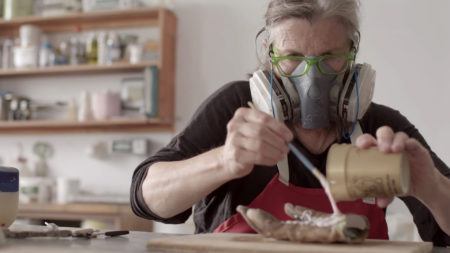Interview
Childhood

Nick Cave at work in his studio, Chicago, 2015. Production still from the Art in the Twenty-First Century Season 8 episode, Chicago. © Art21, Inc. 2016.
Nick Cave recalls the impact of the community in which he was raised and how that encouraged him to pursue his creative interests. Interview by Stanley Nelson at the artist’s studio in Chicago on December 15, 2015.
Art21 How and where did you grow up?
Nick Cave I grew up in Fulton, Missouri—one of seven boys. We lived in a small community with a sense of trust and infrastructure that raised us and really kept us together. I’m very close to my brothers. We were built on this unconditional love, where we are connected and take care of and love each other. It’s been extraordinary.
I grew up around other families and kids. It was the sort of network where other parents were responsible for the wellbeing of each and every one of us. If at six o’clock I was supposed to be in the house, but I’m walking down the street, a neighbor would say, “What are you doing outside? Does your mother know that you’re out here?” There was a sense that these guardians were around me at all times.
Your family wasn’t rich, but did art play a role in your family?
Every night my mother would prepare dinners for us and for this other family that didn’t have food. As kids, we would take turns bringing food to their house. I didn’t know that I grew up without wealth but I grew up unaware of a division between us and them. Growing up with this sense of care and compassion really changed my perspective. I grew up with things you can’t buy. You can’t buy affection; you can’t buy an unconditional connection. You can’t buy trust.
As a kid, I was one of two creative individuals in the family. I have a brother, Jack, who’s also an artist. We grew up learning, being immersed in making things out of nothing. Because we were not privileged, I was making stuff out of whatever was around. When we didn’t win first or second place in art shows, my mother talked us through it, the whole process—that we were still special, still lovely. This amazing infrastructure really cushioned us.
Once, when I was probably twelve, we were going to the grocery store and my grandmother said to me, “You have Papa’s soul,” and she put her hand on my forehead. There was a sense of exchange, a sense of me receiving something. For some reason, I knew that was going to be my guarding, the protection that I needed; I think it has allowed me to move accordingly with my life.
Were you an artistic kid? Was art a big part of your childhood?
It was and wasn’t, at the same time. I was struggling amid six siblings with only sports in their heads. I wasn’t quite interested in sports, but I was trying to find my interests and my way yet still stay connected and be part of this community, in terms of what kids do.
But art has always been part of exercising my interests. I didn’t have access to materials. But I was able to create things based on what was accessible, like surplus or whatever was within my surroundings. It was really about hands-on building things.
My brother Jack and I, in high school, would have these competitive moments, to see who could more quickly paint a watercolor still life or who could better finish an oil painting. I think that energy conditioned me to understand how to handle oneself in a creative situation.

Nick Cave at work in his studio, Chicago, 2015. Production still from the Art in the Twenty-First Century Season 8 episode, Chicago. © Art21, Inc. 2016.
You went to Cranbrook Academy of Art for graduate school, right? What was that like?
It was a bit shocking at the beginning because I was the only minority student there, in 1988. It was difficult because it was the first time that I was confronted with my identity as a Black male. Prior to arriving at Cranbrook, it never entered my mind or my existence, and I never thought that I would be the only minority student there. I tried to understand what that meant, by making a series of drawings about my identity. It was a lot to work through, but it gave me something to respond to, right away. At Cranbrook, students have to design their own pathways, and addressing my identity gave me something to talk about, which was a great initiative to jumpstart my process.
It also seems like that experience gave you focus.
I wanted to address and express in my work the awkwardness, the discomfort, and how the experience made me feel. I started to make work that was about the isolation of my upbringing and my separation from that: Why does it feel uncomfortable to be the only minority at this school? Am I uncomfortable with myself as a Black man?

Nick Cave performing a Soundsuit, 2015. Production still from the Art in the Twenty-First Century Season 8 episode, Chicago. © Art21, Inc. 2016.
Tell me about the first Soundsuit.
The first Soundsuit was made in 1992, in response to the Rodney King incident, the L.A. riots. I was following the story; it made me think about what it feels like to be discarded, dismissed, and profiled. It affected me psychologically: I thought, the moment I step outside of the privacy of my home, I could be profiled. I’m an artist and a professor, yet I could be in a situation in which my career has no effect on what I look like and how I’m perceived.
I was reflecting on that while sitting in the park one day, and I looked down and saw a twig on the ground, as something discarded. Then I proceeded to collect the twigs in the park. That became the catalyst for the first Soundsuit.
I brought the twigs back to the studio and started to build a sculpture. I wasn’t even thinking about the fact that this could physically be worn. When it was done, I realized that I could put it on, which put everything in perspective. Number one: I was building a sort of second skin, which operated as a suit of armor, something that could shield me from society and the world. Number two: it was scary and familiar. It made me think about when I cross the street and hear car doors locking.
Then I realized that when I moved, it made sounds. I thought about the role of protest: in order to be heard, you have to speak louder. And I thought of the outrage of the community that came together, of people who were emotionally charged and disturbed by that incident. Out of all that came a performance-sculpture that changed the direction of my art process. I’m lucky that I had art as a vehicle to express my emotions because I don’t know what I would have done without it, how I would have handled what I was feeling about that incident.

Soundsuit performance, Chicago, 2015. Production still from the Art in the Twenty-First Century Season 8 episode, Chicago. © Art21, Inc. 2016.
The impetus for the Soundsuits originally came from a scary place. But it’s also kind of fun, which makes your work interesting.
I don’t ever see the Soundsuits as fun because they really are coming from a very dark place, but I devise strategies to get viewers onboard, to pull them in. And once they’re in, then there are deeper and more radical meanings. I’m interested in bringing viewers on this journey, but I’ve got to find a way to make it somewhat comforting, accessible, and not difficult because people tend to shy away from difficulties. Once viewers are in, they decide whether to explore what is confronting them or to turn back and head in the other direction.
If work is hard, we tend to not want to respond. I choose to seduce you with beauty; once I have your attention, then we can have a discussion. It’s about how one chooses to enter the work. For me, it’s very dark. The surface may not be dark, but what’s behind the work is very political.
I meant fun as a positive term. It’s part of what makes the work so engaging.
I think a lot of the work is fun because it stems from nostalgia. A lot of my materials are things that we’re familiar with, things we grew up with. It’s about the excessive abundance of stuff; I am negotiating its roles, in the way I build the work and change the value of these things.
I think about my grandparents and the values they placed within the family structure. They were makers and builders, and I’m celebrating that along with ideas that are associated with craft. I’ve always been interested in sitting on the fence [in answering the question]: Is it art or is it craft? With my work, I like to create spaces where the conversation opens up these issues, so we’re able to talk about them.
Talk a little about the juxtaposition of images in your work. How do you go about assembling a new sculpture?
I don’t like to think about it a lot; I look at the objects and I know. A conversation starts to build. What that is and where one may take that is up to the individual. I see partnerships and relationships when I’m searching for materials. I’m taking A and putting it with W, and the chemistry between them dictates the spirit and the energy around the piece. I just make that happen and then let it exist in the world. I want to keep the process loose and organic, and allow everybody to develop their own narratives in relation to the work.
One thing will provoke an idea. I take a found object and move it around the body until I find where I want it to exist. My process is really off-the-cuff. I’m not creating from a sketch. I’m making decisions along the way about construction, about how to bring one element to the next element: what is the fusing, the mortar, that’s holding these things together? I’m always thinking about new ways to approach that.
Your work has an amazing intricacy.
Based on principles of construction and how things are built, one can manipulate and advance materials while creating the work. It creates a different vocabulary. It broadens and secures it. It has solidity because the material becomes part of the building of the work.




